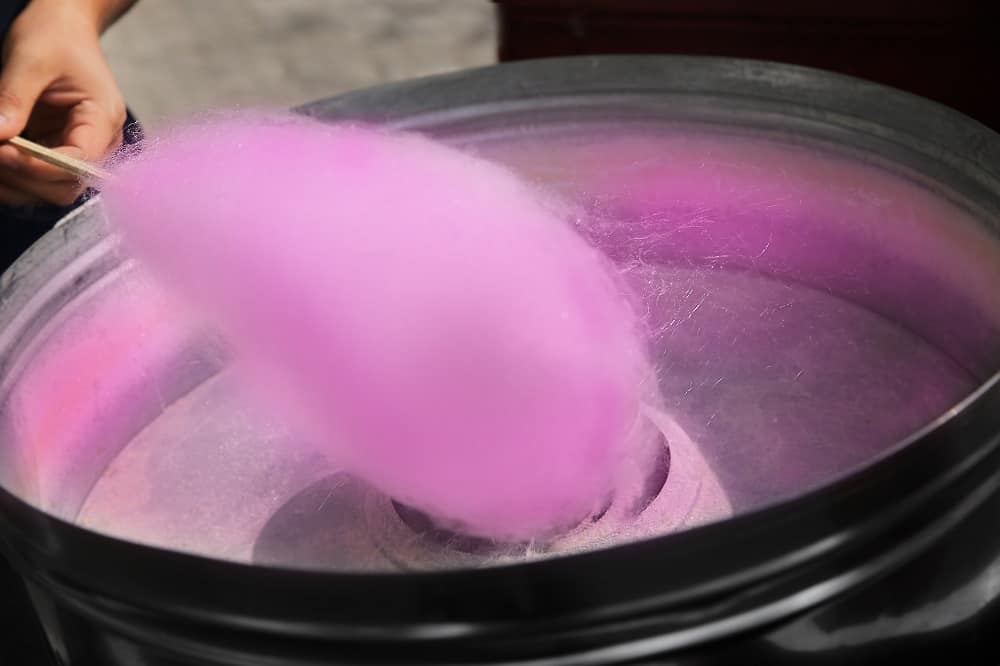A sugary treat commonly associated with festivities such as carnivals and fairs, cotton candy is a popular snack primarily composed of sugar spun into fine threads. Although many have historically claimed to be the inventor of cotton candy, the first patent for a machine to make cotton candy was awarded back in 1899 (1). Though it seems that cotton candy can be rooted back in the US, the sweet treat can now be found in all parts of the globe. Cotton candy can also be found in pre-packaged bags.
Cotton candy is essentially made of sugar which places the treat itself in a gray area for many vegans. Being in the gray area means that there are vegans that would be okay consuming cotton candy while others would rather avoid it. However, with the proper ingredients, vegan cotton candy can exist. Unfortunately, the typical ingredients used in making cotton candy are both gray area ingredients: sugar, natural flavors, and artificial coloring agents.
Table of Contents
Cotton Candy Production
The primary ingredient that makes up cotton candy is sugar. The sweet treat can be made with sugar alone, as long as the necessary equipment is available. However, added ingredients contribute to other flavors and the color of the end result. Thus, typical ingredients that can be found in cotton candy would be sugar, food coloring agents, and flavoring agents. The dry ingredients are essentially mixed to become a homogenous batch.
Although the ingredients of cotton candy are highly rudimentary, the unique process used to make cotton candy converts the sugar mixture to fine threads or floss.

The cotton candy machine can be divided into two main parts: the central spinning element and the basin that catches the cotton candy produced. Basically, the sugar mixture is poured into the central spinning element that also contains heating elements similar to toaster coils. The central spinning element heats up beyond the melting point of sugar.
It should be noted that the central spinning element is adorned with puncture holes all around it. As the melting sugar turns from a solid into a liquid, the liquid sugar then shoots out of the holes as the central component spins at high speeds. However, the liquid sugar also cools very quickly as it is shot out of the central spinning element. As the sugar reverts back to a solid, it retains the shape of threads as it was being ejected from the central spinning element.
Is Cotton Candy Vegan?
Cotton candy is a debatable subject because the typical ingredients that are used for making cotton candy are all considered gray area ingredients. This means that these are ingredients that have some factors as to why some vegans would think twice before deciding if they will consume them anyway or avoid them altogether.
However, this does mean that there are versions of this snack that are perfectly suitable for vegans. It just boils down to the ingredients that are used.
Thus, it is important for vegans to take note of the ingredients found in cotton candy. The following are common ingredients used and why they are avoided by some vegans – but not all.
Sugar
Sugar is a very common additive used in the food industry and it is the primary ingredient used in cotton candy. It can be argued that cotton candy is made completely out of sugar. In many cases, that is true. However, modern cotton candy is added with additional ingredients to add color and flavor.
It is understandable to assume that sugar is vegan since sugar is obtained from plant sources such as sugarcanes or sugar beets. However, sugar is still considered a gray area ingredient because there are instances where sugar is non-vegan – it depends on the production processes involved.
After the sugar has been extracted from the preferred plant source, it is already fit for human consumption in its crude form. However, many sugar companies would subject the sugar to further refinement processes to make the sugar more appealing to the consumers. These additional refinement processes make the sugar whiter and finer.
Many of the processes involved are either physical or chemical in nature. One process in particular is filtration. The sugar juice is passed through a filter to remove non-sugar components, thus increasing the purity of the sugar. Different companies would use different filtration methods. Unfortunately, some sugar companies would use bone char – the charred skeletal remains of animals (2). While bone char is a cheap and effective filter material, it is still an animal product. Thus, sugar produced with bone char cannot be considered vegan.
The problem with using bone char in the sugar industry is that it is not easy to determine the processes involved in the sugar industry. Refinement processes are not typically added to product labels. Furthermore, the problem is exacerbated when sugar is included in products because then a vegan would have to inquire the company if the sugar they are using is vegan or not. At times, it is difficult to get a clear answer – especially when a large food manufacturer has multiple sources of sugar to meets its demands.
Fortunately, vegans around the world are not worried about bone char and sugar because the practice of using bone char in the sugar industry is more prevalent in the US.
Food Coloring Agents
Since cotton candy is conventionally associated with carnivals, fairs, and other festivities, it should come as no surprise that modern cotton candy is characteristically colorful. Since sugar does not provide such vibrant colors, it stands to reason that cotton candy greatly benefits from food coloring agents. There are many food coloring agents that are perfectly appropriate for vegans. However, a significant amount of controversy has surrounded the use of artificial coloring agents.
As the name suggests, artificial coloring agents are food dyes that are completely synthesized in laboratories. Since these artificial coloring agents are synthesized from rudimentary non-animal materials, dietary vegans are perfectly fine with these coloring agents. However, many ethical vegans suggest that these artificial coloring agents are not vegan at all.
Since these coloring agents are synthetic, they have to pass numerous safety standards to get the approval of various food safety authorities. While safety is indeed a priority, the methods used to test it are questionable. Specifically, many vegans find artificial coloring agents to be unethical since they have been tested on animals.
Animal testing is considered a highly unethical practice by today’s standards, especially because modern alternatives can be effectively used such as the use of cell models and in silico studies (i.e., the use of computer models and algorithms).
Natural Flavors
Although the appeal of cotton candy is primarily its sweet sugary taste, it is not uncommon to find cotton candy snacks that come in different flavors. These flavors can be attributed to natural and artificial flavors. Artificial flavors are practically always vegan since they are made from synthetic substances. However, the same cannot be said about natural flavors. Specifically, the FDA defines natural flavors as (3):
“The essential oil, oleoresin, essence or extractive, protein hydrolysate, distillate, or any product of roasting, heating or enzymolysis, which contains the flavoring constituents derived from a spice, fruit or fruit juice, vegetable or vegetable juice, edible yeast, herb, bark, bud, root, leaf or similar plant material, meat, seafood, poultry, eggs, dairy products, or fermentation products thereof, whose significant function in food is flavoring rather than nutritional.”
FDA.gov
The issue with natural flavors as an ingredient is that its umbrella definition encompasses both plant- and animal-derived products. Although the chances of animal products may be low in cotton candy flavors, the inclusion of natural flavors in food products adds a degree of uncertainty that many vegans would rather avoid.
References




